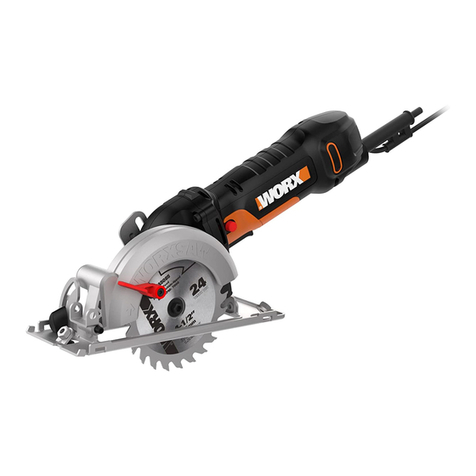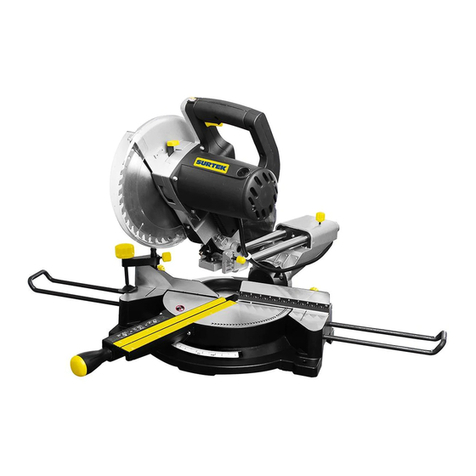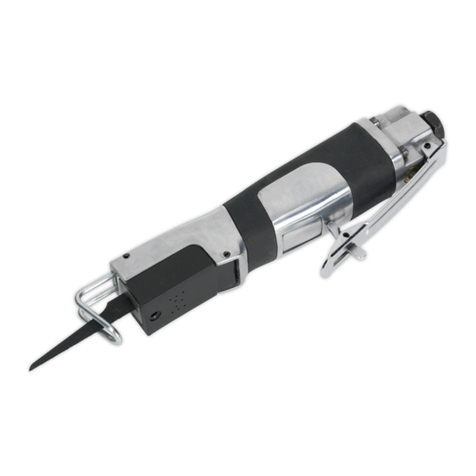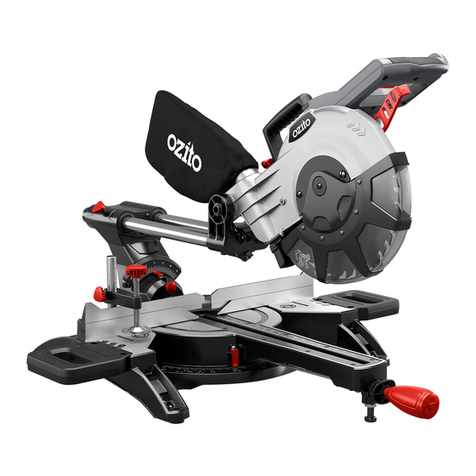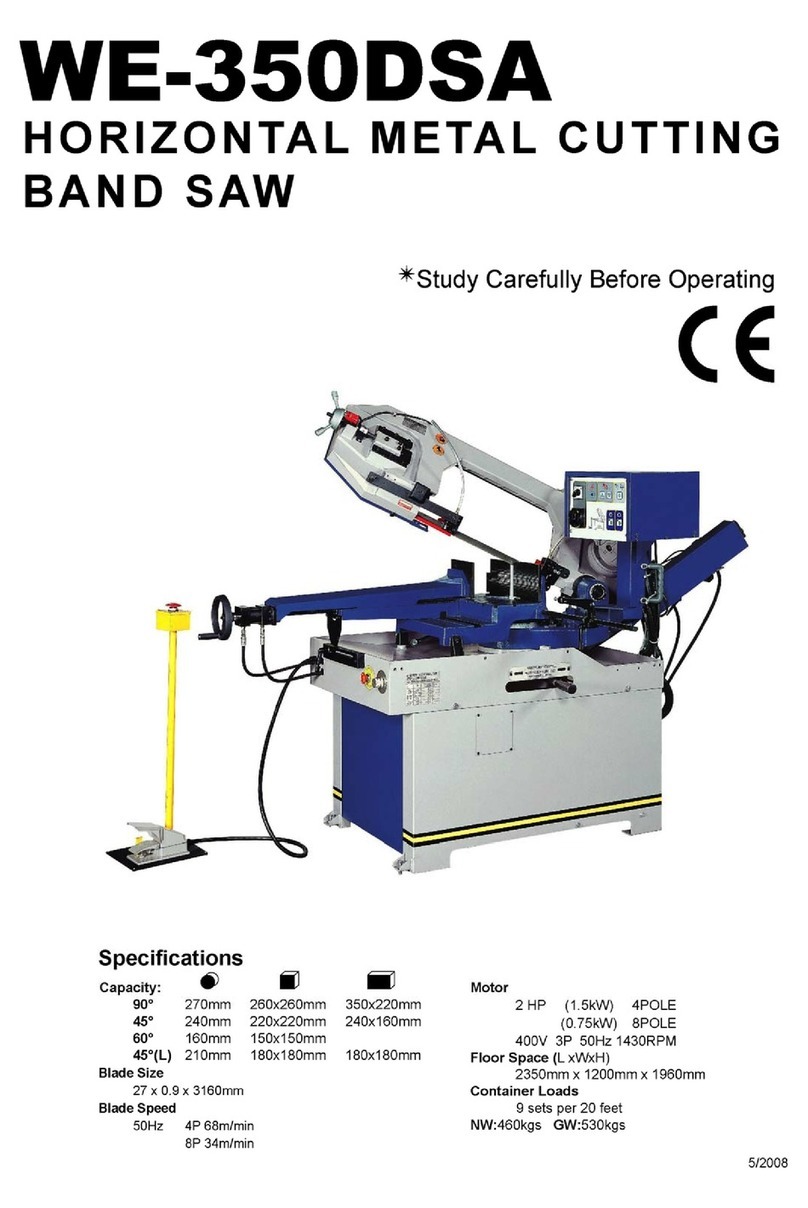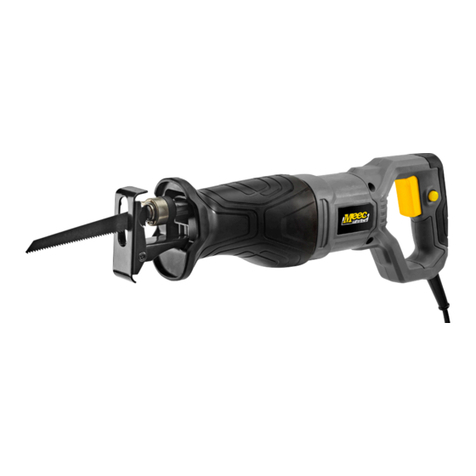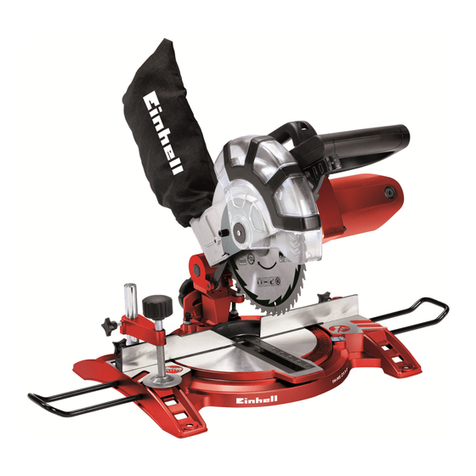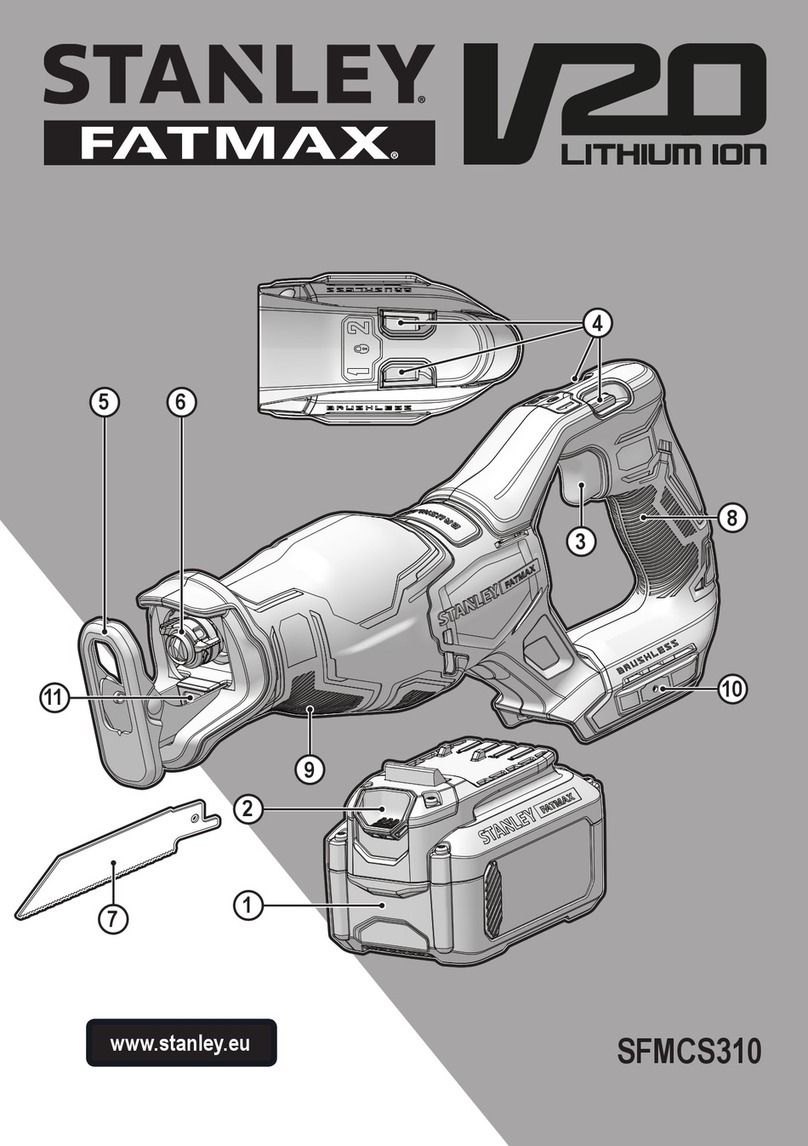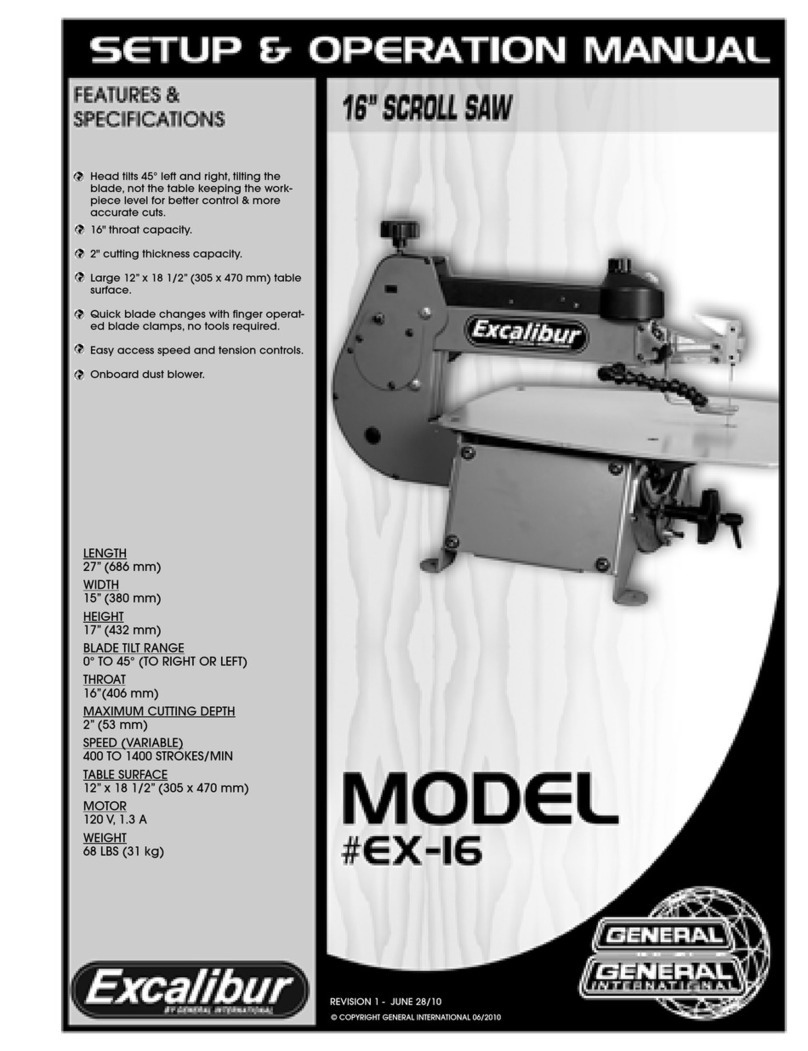Harbor Freight Tools Central Machinery Industrial 95302 Parts list manual

METAL CUTTING BANDSAW
7” - 1 HP
Model
95302
ASSEMBLY AND OPERATION INSTRUCTIONS
Due to continuing improvements, actual product may differ slightly from the product described herein.
®
3491 Mission Oaks Blvd., Camarillo, CA 93011
Visit our website at: http://www.harborfreight.com
TO PREVENT SERIOUS INJURY, READ AND UNDERSTAND
ALL WARNINGS AND INSTRUCTIONS BEFORE USE.
Copyright©2006 by Harbor Freight Tools®. All rights reserved. No portion of this
manual or any artwork contained herein may be reproduced in any shape or form
without the express written consent of Harbor Freight Tools.
For technical questions or replacement parts, please call 1-800-444-3353.

Page 2SKU 95302 For technical questions, please call 1-800-444-3353.
PRODUCT SPECIFICATIONS
Motor 120 V~ / 60 Hz / Single Phase / 1 HP / 1,720 RPM
Power Cord/Plug 14 AWG x 3C SJT / 6’11” Long; 3-Prong, Grounded Plug
Power Switch 2 Position Toggle
Pump 120 V~ / 0.6 A / 3,440 RPM
Overload Protection Resettable Circuit Breaker
Cutting Capacity 7” Diameter Round Stock @ 90° / 5” Diameter Round Stock @ 45°
7” Wide x 8-1/4” High Square Stock @ 90° / 3-3/4” Wide x 4-1/2” High @ 45°
Blade Opening 13” Maximum / 6-1/2” Minimum
Throat Depth 9”
Maximum Vise Capacity 10-3/4”
Vise Miter Angles 0° to 45° in 1° Increments
Drive Type Gear Drive
Variable Speed Knob Controlled / Variable Speed Rheostat
Cutting Speeds 135, 197, & 256 Feet Per Minute
Coolant Tank Capacity 2-1/4 Gallons
Saw Blade 3/4” Wide x .038” T x 93” D / 6 TPI
Overall Dimensions 47” Wide x 15-1/2” Long x 39-1/2” High
Unit Weight 275 Pounds
SAVE THIS MANUAL
You will need this manual for the safety warnings and precautions, assembly, oper-
ating, inspection, maintenance and cleaning procedures, parts list and assembly diagram.
Keep your invoice with this manual. Write the invoice number on the inside of the front
cover. Keep this manual and invoice in a safe and dry place for future reference.
GENERAL SAFETY RULES
WARNING!
READ AND UNDERSTAND ALL INSTRUCTIONS
Failure to follow all instructions listed below may result in
electric shock, fire, and/or serious injury.
SAVE THESE INSTRUCTIONS
WORK AREA
Keep your work area clean and well lit. Cluttered benches and dark areas invite
accidents.
Do not operate power tools in explosive atmospheres, such as in the pres-
ence of flammable liquids, gases, or dust. Power tools create sparks which may
ignite the dust or fumes.
Keep bystanders, children, and visitors away while operating a power tool.
Distractions can cause you to lose control. Protect others in the work area from
debris such as chips and sparks. Provide barriers or shields as needed.
1.
2.
3.

Page 3SKU 95302 For technical questions, please call 1-800-444-3353.
ELECTRICAL SAFETY
Grounded tools must be plugged into an outlet properly installed and grounded
in accordance with all codes and ordinances. Never remove the grounding prong
or modify the plug in any way. Do not use any adapter plugs. Check with a quali-
fied electrician if you are in doubt as to whether the outlet is properly grounded. If
the tools should electrically malfunction or break down, grounding provides a low
resistance path to carry electricity away from the user.
Double insulated tools are equipped with a polarized plug (one blade is
wider than the other). This plug will fit in a polarized outlet only one way. If the
plug does not fit fully in the outlet, reverse the plug. If it still does not fit, contact a
qualified electrician to install a polarized outlet. Do not change the plug in any way.
Double insulation eliminates the need for the three wire grounded power cord
and grounded power supply system.
Avoid body contact with grounded surfaces such as pipes, radiators, ranges,
and refrigerators. There is an increased risk of electric shock if your body is
grounded.
Do not expose power tools to rain or wet conditions. Water entering a power
tool will increase the risk of electric shock.
Do not abuse the Power Cord. Never use the Power Cord to carry the tools or pull
the Plug from an outlet. Keep the Power Cord away from heat, oil, sharp edges,
or moving parts. Replace damaged Power Cords immediately. Damaged Power
Cords increase the risk of electric shock.
When operating a power tool outside, use an outdoor extension cord marked
“W-A” or “W”. These extension cords are rated for outdoor use, and reduce the
risk of electric shock.
PERSONAL SAFETY
Stay alert. Watch what you are doing, and use common sense when operat-
ing a power tool. Do not use a power tool while tired or under the influence
of drugs, alcohol, or medication. A moment of inattention while operating power
tools may result in serious personal injury.
Dress properly. Do not wear loose clothing or jewelry. Contain long hair.
Keep your hair, clothing, and gloves away from moving parts. Loose clothes,
jewelry, or long hair can be caught in moving parts.
Avoid accidental starting. Be sure the Power Switch is off before plugging
in. Carrying power tools with your finger on the Power Switch, or plugging in power
tools with the Power Switch on, invites accidents.
1.
2.
3.
4.
5.
6.
1.
2.
3.

Page 4SKU 95302 For technical questions, please call 1-800-444-3353.
Remove adjusting keys or wrenches before turning the power tool on. A
wrench or a key that is left attached to a rotating part of the power tool may result
in personal injury.
Do not overreach. Keep proper footing and balance at all times. Proper footing
and balance enables better control of the power tool in unexpected situations.
Use safety equipment. Always wear eye protection. Dust mask, non-skid safety
shoes, hard hat, or hearing protection must be used for appropriate conditions.
TOOL USE AND CARE
Use clamps (not included) or other practical ways to secure and support the
workpiece to a stable platform. Holding the work by hand or against your body
is unstable and may lead to loss of control.
Do not force the tool. Use the correct tool for your application. The correct
tool will do the job better and safer at the rate for which it is designed.
Do not use the power tool if the Power Switch does not turn it on or off. Any
tool that cannot be controlled with the Power Switch is dangerous and must be
replaced.
Disconnect the Power Cord Plug from the power source before making any
adjustments, changing accessories, or storing the tool. Such preventive safety
measures reduce the risk of starting the tool accidentally.
Store idle tools out of reach of children and other untrained persons. Tools
are dangerous in the hands of untrained users.
Maintain tools with care. Keep cutting tools sharp and clean. Properly main-
tained tools with a sharp cutting edge are less likely to bind and are easier to control.
Do not use a damaged tool. Tag damaged tools “Do not use” until repaired.
Check for misalignment or binding of moving parts, breakage of parts, and any
other condition that may affect the tool’s operation. If damaged, have the tool
serviced before using. Many accidents are caused by poorly maintained tools.
Use only accessories that are recommended by the manufacturer for your
model. Accessories that may be suitable for one tool may become hazardous
when used on another tool.
SERVICE
Tool service must be performed only by qualified repair personnel. Service or
maintenance performed by unqualified personnel could result in a risk of injury.
When servicing a tool, use only identical replacement parts. Follow instruc-
tions in the “Inspection, Maintenance, And Cleaning” section of this manual.
4.
5.
6.
1.
2.
3.
4.
5.
6.
7.
8.
1.
2.

Page 5SKU 95302 For technical questions, please call 1-800-444-3353.
Use of unauthorized parts or failure to follow maintenance instructions may create
a risk of electric shock or injury.
SPECIFIC SAFETY RULES
Maintain labels and nameplates on the Bandsaw. These carry important infor-
mation. If unreadable or missing, contact Harbor Freight Tools for a replacement.
Always wear safety impact eye goggles and heavy work gloves
when using the Bandsaw. Using personal safety devices reduce the
risk for injury. Safety impact eye goggles and heavy work gloves are
available from Harbor Freight Tools.
Maintain a safe working environment. Keep the work area well lit. Make sure
there is adequate surrounding workspace. Always keep the work area free of ob-
structions, grease, oil, trash, and other debris. Do not use a power tool in areas
near flammable chemicals, dusts, and vapors. Do not use this product in a damp
or wet location.
Avoid unintentional starting. Make sure you are prepared to begin work before
turning on the Bandsaw.
Do not force the Bandsaw. This tool will do the work better and safer at the
speed and capacity for which it was designed. Do not force the Saw Blade into the
workpiece being cut.
WARNING! Keep hands and fingers away from cutting area and Saw Blade.
Never leave the Bandsaw unattended when it is plugged into an electrical
outlet. Turn off the tool, and unplug it from its electrical outlet before leaving.
Make sure the Bandsaw is located on a flat, level, sturdy surface capable of
supporting the weight of the Saw and work pieces. Always “chock” the Wheels
to prevent the Bandsaw from accidentally moving.
Make sure the Table of the Bandsaw and surrounding area are clear with the
exception of the workpiece to be cut.
Before using the Bandsaw, check to make sure the Saw Blade is prop-erly
mounted and is not cracked or bent.
Industrial applications must follow OSHA guidelines.
Never stand on the Bandsaw. Serious injury could result if the Bandsaw is tipped
or if the rotating Saw Blade is accidently contacted.
Never attempt to cut more than one workpiece at a time.
Never attempt to cut freehand. Make sure the workpiece to be cut is pressed
firmly against the Table and/or secured in the Vise.
1.
2.
3.
4.
5.
6.
7.
8.
9.
10.
11.
12.
13.
14.

Page 6SKU 95302 For technical questions, please call 1-800-444-3353.
When cutting a large workpiece, make sure its entire length is properly sup-
ported. If necessary, use a roller stand (not included).
Do not lean on the Bandsaw when the tool is in its upright position.
When moving the Bandsaw, always have its Head lowered to its horizontal
position.
Allow the Saw Blade to rotate to full speed before feeding a workpiece into
the Blade. When turning off the Bandsaw, allow the Saw Blade to spin down and
stop on its own. Do not press against the Saw Blade to stop it.
To avoid accidental injury, always wear heavy duty work gloves when chang-
ing the Saw Blade.
The Saw Blade will become hot while cutting. Allow the Saw Blade to completely
cool before handling.
Do not force the workpiece into the Saw Blade when cutting. Apply moder-ate
pressure, allowing the Saw Blade to cut without being forced.
Turn off the Bandsaw and allow the Saw Blade to completely stop if the Saw
Blade is to be backed out of an uncompleted cut.
Never attempt to remove material stuck in the moving parts of the Bandsaw
while it is plugged in and running.
Make sure the workpiece to be cut off has sufficient room to move side-ways.
Failure to do so may result in off-cut binding against the Saw Blade.
Always unplug the Bandsaw from its electrical outlet before perform-ing and
inspection, maintenance, or cleaning procedures.
Keep this product and all other tools and equipment away from children and
animals. Do not allow spectators in the work area.
Keep all safety guards in place and in proper working order.
This Bandsaw is designed for indoor use only.
When operating the machine, keep the Bandsaw Blade enclosure closed.
WARNING! Some dust created by power sanding, sawing, grinding, drilling, and
other construction activities, contain chemicals known (to the State of California) to
cause cancer, birth defects or other reproductive harm. Some examples of these
chemicals are: lead from lead-based paints, crystalline silica from bricks and ce-
ment or other masonry products, arsenic and chromium from chemically treated
lumber. Your risk from these exposures varies, depending on how often you do this
type of work. To reduce your exposure to these chemicals: work in a well ventilated
area, and work with approved safety equipment, such as those dust masks that are
15.
16.
17.
18.
19.
20.
21.
22.
23.
24.
25.
26.
27.
28.
29.
30.

Page 7SKU 95302 For technical questions, please call 1-800-444-3353.
specially designed to filter out microscopic particles.
(California Health & Safety Code § 25249.5, et seq.)
WARNING! People with pacemakers should consult their physician(s) before using
this product. Electromagnetic fields in close proximity to a heart pacemaker could
cause interference to or failure of the pacemaker.
WARNING! The warnings and cautions discussed in this manual cannot cover all
possible conditions and situations that may occur. It must be understood by the
operator that common sense and caution are factors which cannot be built into this
product, but must be supplied by the operator.
SAVE THESE INSTRUCTIONS
GROUNDING
WARNING!
Improperly connecting the grounding wire can result in the risk of electric shock.
Check with a qualified electrician if you are in doubt as to whether the outlet is
properly grounded. Do not modify the power cord plug provided with the tool.
Never remove the grounding prong from the plug. Do not use the tool if the
power cord or plug is damaged. If damaged, have it repaired by a service facil-
ity before use. If the plug will not fit the outlet, have a proper outlet installed by
a qualified electrician.
GROUNDED TOOLS: TOOLS WITH THREE PRONG PLUGS
Note: This product uses a 3-prong plug.
Tools marked with “Grounding Required” have a three wire cord and three prong
grounding plug. The plug must be connected to a properly grounded outlet. If the
tool should electrically malfunction or break down, grounding provides a low resis-
tance path to carry electricity away from the user, reducing the risk of electric shock.
(See 3-Prong Plug and Outlet, next page.)
The grounding prong in the plug is connected through the green wire inside the
cord to the grounding system in the tool. The green wire in the cord must be the
only wire connected to the tool’s grounding system and must never be attached to
an electrically “live” terminal. (See 3-Prong Plug and Outlet.)
31.
32.
1.
2.

Page 8SKU 95302 For technical questions, please call 1-800-444-3353.
Your tool must be plugged into an appropriate outlet, properly installed and grounded
in accordance with all codes and ordinances. The plug and outlet should look like
those in the following illustration. (See 3-Prong Plug and Outlet.)
3-Prong Plug and Outlet Outlets for 2-Prong Plug
DOUBLE INSULATED TOOLS: TOOLS WITH TWO PRONG PLUGS
Tools marked “Double Insulated” do not require grounding. They have a special
double insulation system which satisfies OSHA requirements and complies with
the applicable standards of Underwriters Laboratories, Inc., the Canadian Standard
Association, and the National Electrical Code. (See Outlets for 2-Prong Plug.)
Double insulated tools may be used in either of the 120 volt outlets shown in the
preceding illustration. (See Outlets for 2-Prong Plug.)
EXTENSION CORDS
Grounded tools require a three wire extension cord. Double Insulated tools can
use either a two or three wire extension cord.
As the distance from the supply outlet increases, you must use a heavier gauge
extension cord. Using extension cords with inadequately sized wire causes a seri-
ous drop in voltage, resulting in loss of power and possible tool damage.
(See Table A.)
The smaller the gauge number of the wire, the greater the capacity of the cord. For
example, a 14 gauge cord can carry a higher current than a 16 gauge cord.
(See Table A.)
When using more than one extension cord to make up the total length, make sure
each cord contains at least the minimum wire size required. (See Table A.)
If you are using one extension cord for more than one tool, add the nameplate am-
peres and use the sum to determine the required minimum cord size.
(See Table A.)
If you are using an extension cord outdoors, make sure it is marked with the suffix
“W-A” (“W” in Canada) to indicate it is acceptable for outdoor use.
3.
1.
2.
1.
2.
3.
4.
5.
6.

Page 9SKU 95302 For technical questions, please call 1-800-444-3353.
Make sure your extension cord is properly wired and in good electrical condition.
Always replace a damaged extension cord or have it repaired by a qualified electri-
cian before using it.
Protect your extension cords from sharp objects, excessive heat, and damp or wet
areas.
RECOMMENDED MINIMUM WIRE GAUGE FOR EXTENSION CORDS*
(120 OR 240 VOLT)
NAMEPLATE
AMPERES
(at full load)
EXTENSION CORD LENGTH
25 Feet 50 Feet 75 Feet 100 Feet 150 Feet
0 – 2.0 18 18 18 18 16
2.1 – 3.4 18 18 18 16 14
3.5 – 5.0 18 18 16 14 12
5.1 – 7.0 18 16 14 12 12
7.1 – 12.0 18 14 12 10 -
12.1 – 16.0 14 12 10 - -
16.1 – 20.0 12 10 - - -
TABLE A * Based on limiting the line voltage drop to five volts at 150% of the rated amperes.
SYMBOLOGY
Double Insulated
Canadian Standards Association
Underwriters Laboratories, Inc.
V~ Volts Alternating Current
AAmperes
n0xxxx/min. No Load Revolutions per Minute (RPM)
7.
8.

Page 10SKU 95302 For technical questions, please call 1-800-444-3353.
UNPACKING
When unpacking, check to make sure all the parts shown on the Parts Lists near
the end of this manual are included. If any parts are missing or broken, please call Harbor
Freight Tools at the number shown on the cover of this manual as soon as possible.
ASSEMBLY INSTRUCTIONS
Note: For additional information regarding the parts listed in the following pages, refer to
the Assembly Diagrams near the end of this manual.
CAUTION! Always make sure the Toggle Switch (750-5) for the Bandsaw and
the Toggle Switch (750-5) for the Coolant Pump are both in their “OFF” position and
the tool is unplugged from its electrical outlet prior to assembling the tool, adding
any accessories, or making adjustments to the tool.
CAUTION! Always wear heavy-duty work gloves to protect from sharp metal
edges.
To Attach The Wheels:
NOTE: This Bandsaw weighs approximately 275 pounds and you will need the
assistance of additional personnel and an adequate lifting device.
Use a lifting device to raise the right side of the Stand (77S) of the Bandsaw about
six inches off the floor. Once the Stand is lifted, insert a Wheel Rod (92-4) through
the two holes located at the bottom of the Stand. Slide one Wheel (92-2) on each
end of the Wheel Rod. Place one Washer (92-1) on each end of the Wheel Rod.
Insert one Cotter Pin (92-3) through the hole in each end of the Wheel Rod. Make
sure to bend the Cotter Pins to secure the Wheels in place. Then, lower the Stand
to the floor surface. (See Assy Diagram, page 30.)
To Attach The Levelers:
NOTE: For this procedure, you will need the assistance of additional personnel
and an adequate lifting device.
Use a lifting device to raise the left side of the Stand (77S) of the Bandsaw about
six inches off the floor. Once the Stand is lifted, screw in the two Levelers (93-2)
through the two threaded holes located at the bottom of the Stand. Lower the Stand
to the floor surface. Then, use the accessory Level (866) to properly level the Stand.
(See Assy Diagram, page 30.)
1.
2.
1.
2.

Page 11SKU 95302 For technical questions, please call 1-800-444-3353.
To Attach The Hand Rod:
Align the four mounting holes in the Hand Rod (98-1) with the four mounting holes
in the left side of the Stand (77S). Insert four Hex Head Screws (98-2), with four
Washers (98-3), through the mounting holes in the Hand Rod and Stand. Then
secure the Hand Rod to the Stand with four Washers (98-3) and four Hex Nuts (98-
4). (See Assy. Diagram, page 30.)
To Attach The Stock Stop Rod And Block:
Slide the Stock Stop Rod (40) into the mounting hole in the Swivel Base (1), and
secure the Stock Stop Rod by tightening the Hex Head Screw (39).
(See Assy. Diagram, page 30.)
Slide the Stop Block (41) onto the Stock Stop Rod (40), and secure by tightening
the Thumb Screw (38). (See Assy. Diagram, page 30.)
1.
2.
OPERATING INSTRUCTIONS
CAUTION! Always make sure the Toggle Switch (750-5) for the Bandsaw and
the Toggle Switch (750-5) for the Coolant Pump are both in their “OFF” positions
and the tool is unplugged from its electrical outlet prior to making adjustments to
the tool.
Selecting Proper Blade Speeds:
Material Speed (Feet Per Minute)
Tool Steel
135
Stainless Steel
Alloy Steel
Cast Iron Steel
Low-Alloy Carbon Steel 197
Soft Brass
Soft Iron
Aluminum 256
Plastic
FIGURE E
When using the Bandsaw always change the blade speed to best suit the material
being cut. The Blade Speed Chart illustrates several settings for several types of
materials. (See Figure E.)
1.

Page 12SKU 95302 For technical questions, please call 1-800-444-3353.
SPEED INDICATOR DIAL
(800-7)
FIGURE F
To change the blade speed according to the material being cut, turn the Speed
Indicator Dial (800-7) to the necessary speed. IMPORTANT: Do not attempt to
change the speed while the Bandsaw is running. Always make sure the Bandsaw
is at a complete stop prior to changing speeds. (See Figure F.)
To Use The Quick Vise:
FIGURE G
FRONT VISE JAW (9)
KNOB
(600)
SHAFT
(609)
The Bandsaw is equipped with a “quick action” Vise which allows you to instantly
position the moveable Front Vise Jaw (9). To operate, turn the Shaft (609) to its
vertical position. Turn the Knob (600) clockwise or counterclockwise and move
the Front Vise Jaw to the desired position. Then tighten the Front Vise against the
workpiece by turning the Shaft to its horizontal position. (See Figure G.)
To Use The Quick Vise Adjustment For An Angle Cut:
FRONT VISE JAW
(9)
SCALE
(13)
SWIVEL
BASE
(1)
THREADED HOLE
SCREW
(20)
SCREW (21)
REAR VISE JAW (22)
SCREW (21)
FIGURE H
Loosen the four Screws (20, 21). Adjust the Rear Vise Jaw (22) to the threaded
hole position. Set the Scale (13) to the desired angle. Adjust the Front Vise Jaw
(9) to parallel the Rear Vise jaw. Then, re-tighten the four Screws.
(See Figure H.)
2.

Page 13SKU 95302 For technical questions, please call 1-800-444-3353.
To Adjust The Stop Block:
Loosen the Thumb Screw (38) that holds the Stop
Block (41) to the Stock Stop Rod (40).
(See Figure I.)
Adjust the Stop Block (41) to the desired length
position. Then, re-tighten the Thumb Screw (38).
(See Figure I.)
1.
2.
THUMB
SCREW
(38) STOP
BLOCK
(41)
STOCK
STOP ROD (41)
(WORKPIECE
NOT INCLUDED)
FIGURE I
THUMB
SCREW
(38) STOP
BLOCK
(41)
STOCK
STOP ROD (41)
(WORKPIECE
NOT INCLUDED)
FIGURE I
To Convert The Bandsaw For Vertical Use:
NOTE: Notching, slitting, and contour work is best
done with the Bandsaw in its vertical position.
Raise the Saw Head to its full vertical position,
making sure it locks in position by turning the Cyl-
inder (216) to its “OFF” position. (See Figure J.)
Remove the two Screws (266-7), and remove the
Small Vertical Cutting Plate
(266-3). (See Figure K.)
Guide the Saw Blade (251) through the slot in the
Large Vertical Cutting Plate (867), and secure it in
position with the two Screws (266-7).
(See Figure K.)
1.
2.
3.
4.
CYLINDER
(216)
FIGURE J
CYLINDER
(216)
FIGURE J
SCREWS (266-7)
SMALL VERTICAL CUTTING PLATE (266-3) SCREWS (266-7)
SAW
BLADE
(251)
FIGURE K
LARGE VERTICAL CUTTING PLATE
(867)

Page 14SKU 95302 For technical questions, please call 1-800-444-3353.
Adjusting The Blade Guide Bearings:
NOTE: Blade Guide Bearings (266-10) adjustment is a critical factor in the perfor-
mance of the Bandsaw. (See Figure L.)
It is always best to try a new Saw Blade (251) to see if it will correct poor cutting
before attempting to adjust the Blade Guide Bearings. For example, if a Saw Blade
becomes dull on one side sooner than the other, it will begin cutting crooked. A
Saw Blade replacement will correct this problem, whereas Blade Guide Bearings
adjustment will not. (See Figure L.)
If a new Saw Blade does not correct the problem, check the clearance between the
Saw Blade and Blade Guide Bearings (266-10) to obtain the proper clearance.
NOTE: There should only be minimal clearance between the Saw Blade and Blade
Guide Bearings (266-10). To obtain this clearance adjust as follows:
The Outer Blade Guide Bearings (266-10) are mounted to Guide Pivot Assem-
blies (270S) and can be adjusted. (See Figure L.)
Loosen the Hex Socket Head Screw (269-9) while holding the Guide Pivot As-
sembly (270S) with an Allen wrench (not included). (See Figure L.)
Position the Guide Pivot Assembly (270S) by turning it to the desired position
of clearance. Then, re-tighten the Hex Socket Head Screw (269-9).
(See Figure L.)
Adjust the second Blade Guide Bearing (266-10) in the same manner.
1.
2.
3.
a.
b.
c.
d.
GUIDE PIVOT
ASSEMBLY
(270S)
BLADE
GUIDE
BEARING
(266-10)
SAW BLADE
(251)
BLADE
GUIDE
BEARING
(266-10)
HEX SOCKET
HEAD SCREW
(269-9)
FIGURE L

Page 15SKU 95302 For technical questions, please call 1-800-444-3353.
Adjusting The Blade Tracking:
Raise the Saw Head to its full vertical position, making sure it locks in position by
turning the Cylinder (216) to its “OFF” position. (See Figure J.)
ADJUSTING
HEX HEAD
SCREW
(240)
HEX HEAD
SCREW
(243)
IDLER
WHEEL
(250-1)
ADJUSTABLE
BLADE KNOB
(245)
FIGURE M
Turn on the Bandsaw. The Saw Blade (251) is tracking properly when the back of
the Blade is just touching the edge of the Idler Wheel (250-1) flange. The back of
the Blade should not be rubbing against the flange. (See Figure M.)
If adjustment is necessary, the Blade Guide Bearings (266-10) should be clear of
the Saw Blade (251). (See Figure M.)
Loosen the upper Hex Head Screw (243) to a point where it is just barely snug.
(See Figure M.)
With the Bandsaw running, turn the Adjusting Hex Head Screw (240) until the Saw
Blade (251) is tracking properly, making sure Blade tension is maintained by turning
the Adjustable Blade Knob (245). (See Figure M.)
Make sure to retighten the upper Hex Head Screw (243) when adjustment is com-
plete. (See Figure M.)
Adjusting The Blade Tension:
Turn the Adjustable Blade Knob (245) clockwise to increase tension on the Saw
Blade (251). Turn the Adjustable Blade Knob counterclockwise to decrease tension
on the Saw Blade. Correct tension is acquired when the Saw Blade is just tight
enough so that no slippage occurs between the Saw Blade and the Wheels (231S,
250-1). (See Figure M.)
NOTE: When the Bandsaw is not in use over long periods of time, release the ten-
sion on the Saw Blade (251).
1.
2.
3.
4.
5.
6.
1.
2.

Page 16SKU 95302 For technical questions, please call 1-800-444-3353.
Adjusting The Feed Rate:
SPRING
ADJUSTING
ROD
(32)
FIGURE N
The feed rate of the Saw Arm can be adjusted by turning the Spring Adjusting Rod
(32) clockwise to decrease the feed rate or counterclockwise to increase the feed
rate. Do not turn the Spring Adjusting Rod more than one turn at a time. Excessive
feed pressure can break the Saw Blade (251). Insufficient feed pressure dulls the
Saw Blade rapidly. (See Figure N.)
Adjusting The Blade Guide Brackets:
ADJUSTABLE BRACKET (269S)
ADJUSTABLE BLADE KNOB (261)
FIGURE O
The Adjustable Blade Knob (261) is adjustable by loosening the Knob and sliding
the Bracket (269S) up or down to accommodate the width of the workpiece.
(See Figure O.)
The Adjustable Bracket (269S) should be set as close as possible to the workpiece,
without interfering with the workpiece or contacting the Swivel Base (1).
(See Figure O.)
Once the adjustment is made, make sure to re-tighten the Adjustable Blade Knob
(261). (See Figure O.)
1.
2.
3.

Page 17SKU 95302 For technical questions, please call 1-800-444-3353.
Basic Bandsaw Operation -- Vertical Position:
WARNING! Always wear ANSI approved safety impact eye goggles when operat-
ing the Bandsaw.
WARNING! When operating the machine, keep the Bandsaw Blade enclosure
closed.
Do not plug the Power Cable (500) into an electrical outlet until all necessary
adjustments (as previously discussed in this manual) have been made.
COOLANT PUMP
FITTING
(91S)
COOLANT PUMP
TOGGLE SWITCH
(750-5)
CYLINDER
(216)
POWER CABLE
(500)
MOTOR
TOGGLE
SWITCH
(750-5)
SAW BLADE
(251)
LARGE VERTICAL CUTTING PLATE (867)
SAW HEAD ASSEMBLY
FIGURE P
Raise the Saw Head to its full vertical position, making sure it locks in place by
turning the Cylinder (216) to its “OFF” position. (See Figure P.)
Once all necessary adjustments to the Bandsaw have been made, plug the Power
Cable (500) into the nearest 115 volt, grounded, electrical outlet.
Turn the Coolant Pump Fitting (91S) to its “OPEN” position. Then, turn the Coolant
Pump Toggle Switch (750-5) to its “ON” position. (See Figure P.)
Turn the Motor Toggle Switch (750-5) to its “ON” position. (See Figure P.)
CAUTION! Cut only flat work pieces when the Bandsaw is in its vertical position.
Never attempt to cut pipes or other round objects with the Bandsaw in its vertical
position.
Before cutting, turn on the Bandsaw and check for excessively loose Saw Blade
(251) tension or machine vibration. If this is found, turn off the Bandsaw and correct
the problem before using. (See Figure P.)
Set the workpiece on the Large Vertical Cutting Plate (867), making sure to keep
downward pressure on the workpiece throughout the cutting process.
(See Figure P.)
1.
2.
3.
4.
5.
6.
7.
8.
9.
10.

Page 18SKU 95302 For technical questions, please call 1-800-444-3353.
When cutting a large workpiece, make sure its entire length is properly supported.
If necessary, use a roller stand (not included) with a larger workpiece.
Allow the Saw Blade (251) to turn up to full speed before feeding the workpiece into
the Saw Blade. (See Figure P.)
WARNING! Always keep hands and fingers safely away from the cutting
area.
Feed the workpiece into the Saw Blade (251) gradually. Do not force the Bandsaw to
remove material faster than it is designed to cut. Never attempt to remove material
stuck in the moving parts of the Bandsaw while it is plugged in and running. Turn
off the Bandsaw if the workpiece is to be backed out of an uncompleted cut.
Once the cut is made, turn the Motor Toggle Switch (750-5) to its “OFF” position.
Turn the Coolant Pump Toggle Switch (750-5) to its “OFF” position. Turn the Cool-
ant Pump Fitting (91S) to its “CLOSED” position. Then, unplug the Power Cable
(500) from its electrical outlet. (See Figure P.)
Wait until the Saw Blade (251) comes to a complete stop. Then, remove the work-
piece and scrap material from the Large Vertical Cutting Plate (867).
(See Figure P.)
Turn the Cylinder (216) to its “ON” position. Slowly lower the Saw Head to its hori-
zontal position. Then, turn the Hydraulic Cylinder to its “OFF” position to lock the
Saw Head in place. (See Figure P.)
Basic Bandsaw Operation -- Horizontal Position:
WARNING! Always wear ANSI approved safety impact eye goggles when operat-
ing the Bandsaw.
Do not plug the Power Cable (500) into an electrical outlet until all necessary
adjustments (as previously discussed in this manual) have been made.
Turn the Cylinder (216) to its “ON” position, and raise the Saw Head to its full verti-
cal position. Then, turn the Cylinder to its “OFF” position to lock the Saw Head in
place. (See Figure Q, next page.)
Secure the workpiece in the Vise assembly (9, 22). When cutting a large workpiece,
make sure its entire length is properly supported. If necessary, use a roller stand
(not included) with a larger workpiece. (See Figure Q.)
If cutting several work pieces at the same length, you may wish to adjust the Stop
Block (41) to the desired position. (See Figure I.)
Once all necessary adjustments to the Bandsaw have been made, plug the Power
Cable (500) into the nearest 115 volt, grounded, electrical outlet.
11.
12.
13.
14.
15.
16.
17.
1.
2.
3.
4.
5.
6.

Page 19SKU 95302 For technical questions, please call 1-800-444-3353.
COOLANT PUMP
TOGGLE SWITCH
(750-5)
MOTOR
TOGGLE
SWITCH
(750-5)
COOLANT PUMP
FITTING
(91S) CYLINDER
(216)
SAW HEAD
ASSEMBLY
FIGURE Q
Turn the Cylinder (216) to its “ON” position, and slowly lower the Saw Head until
the Saw Blade (251) is just above the workpiece cut line. (See Figure Q.)
Turn the Coolant Pump Fitting (91S) to its “OPEN” position. Then, turn the Coolant
Pump Toggle Switch (750-5) to its “ON” position. (See Figure Q.)
Turn the Motor Toggle Switch (750-5) to its “ON” position. (See Figure Q.)
Before cutting, turn on the Bandsaw and check for excessively loose Saw Blade
(251) tension or machine vibration. If this is found, turn off the Bandsaw and correct
the problem before using. (See Figure Q.)
Allow the Saw Blade (251) to turn up to full speed before feeding the Saw Blade
into the workpiece. (See Figure Q.)
WARNING! Always keep hands and fingers safely away from the cut-
ting area.
Allow the Saw Arm to automatically lower on its own, while it gradually feeds the
Saw Blade (251) into the workpiece. Do not force the Bandsaw to remove material
faster than it is designed to cut. NOTE: The speed at which the Saw Arm moves
downward may be increased or decreased by adjusting the valve on the Cylinder
(216). (See Figure Q.)
7.
8.
9.
10.
11.
12.
13.

Page 20SKU 95302 For technical questions, please call 1-800-444-3353.
Never attempt to remove material stuck in the moving parts of the Bandsaw while
it is plugged in and running. Turn off the Bandsaw if the workpiece is to be backed
out of an uncompleted cut.
IMPORTANT: When in the horizontal cutting mode only, the Motor Toggle Switch
(750-5) will automatically turn to its “OFF” position and shut off the Bandsaw’s Mo-
tor when the cut has been completed.
Once the cut is made, check to make sure the Motor Toggle Switch (750-5) is in its
“OFF” position. Turn the Coolant Pump Toggle Switch (750-5) to its “OFF” posi-
tion. Turn the Coolant Pump Fitting (91S) to its “CLOSED” position. Then, unplug
the Power Cable (500) from its electrical outlet. (See Figure Q.)
Wait until the Saw Blade (251) comes to a complete stop. Then, raise the Saw Head
to its full vertical position. Turn the Cylinder (216) to its “OFF” position to lock the
Saw Head in place. Remove the workpiece from the Vise assembly (9, 22) and
scrap material from the Swivel Base (1) of the Bandsaw. (See Figure Q.)
Turn the Cylinder (216) to its “ON” position. Slowly lower the Saw Head to its hori-
zontal position. Then, turn the Cylinder to its “OFF” position to lock the Saw Head
in place. (See Figure Q.)
14.
15.
16.
17.
18.
Table of contents
Other Harbor Freight Tools Saw manuals
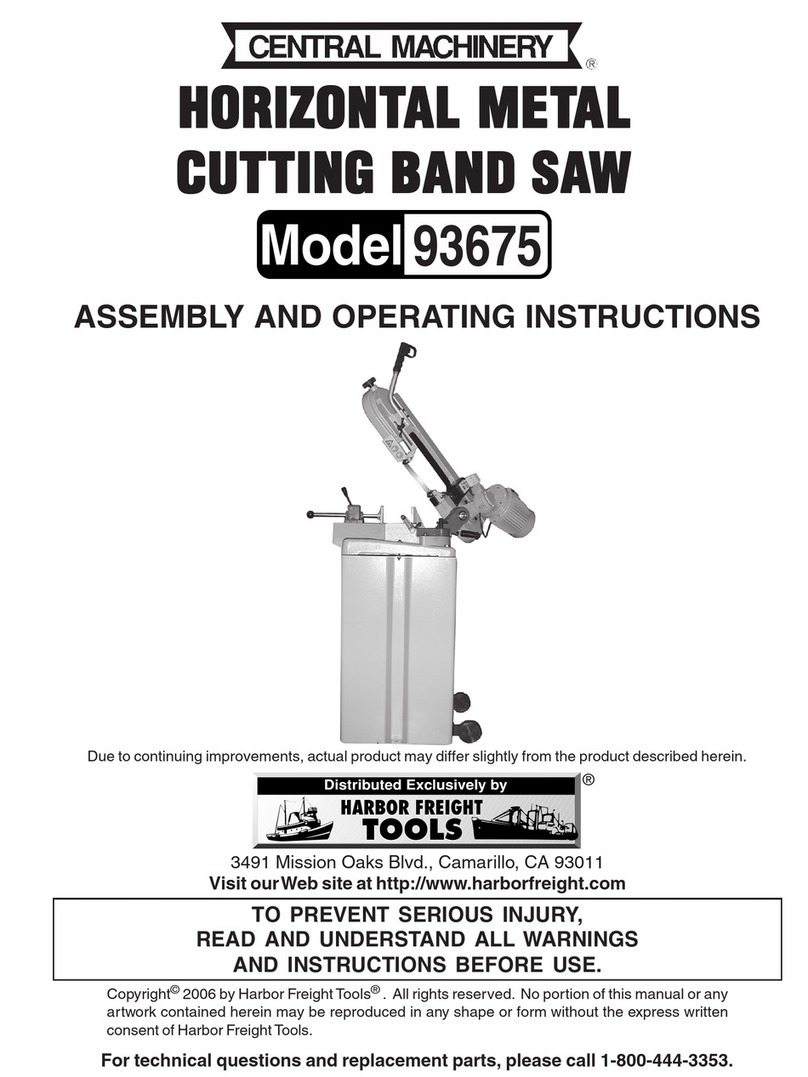
Harbor Freight Tools
Harbor Freight Tools 93675 User manual
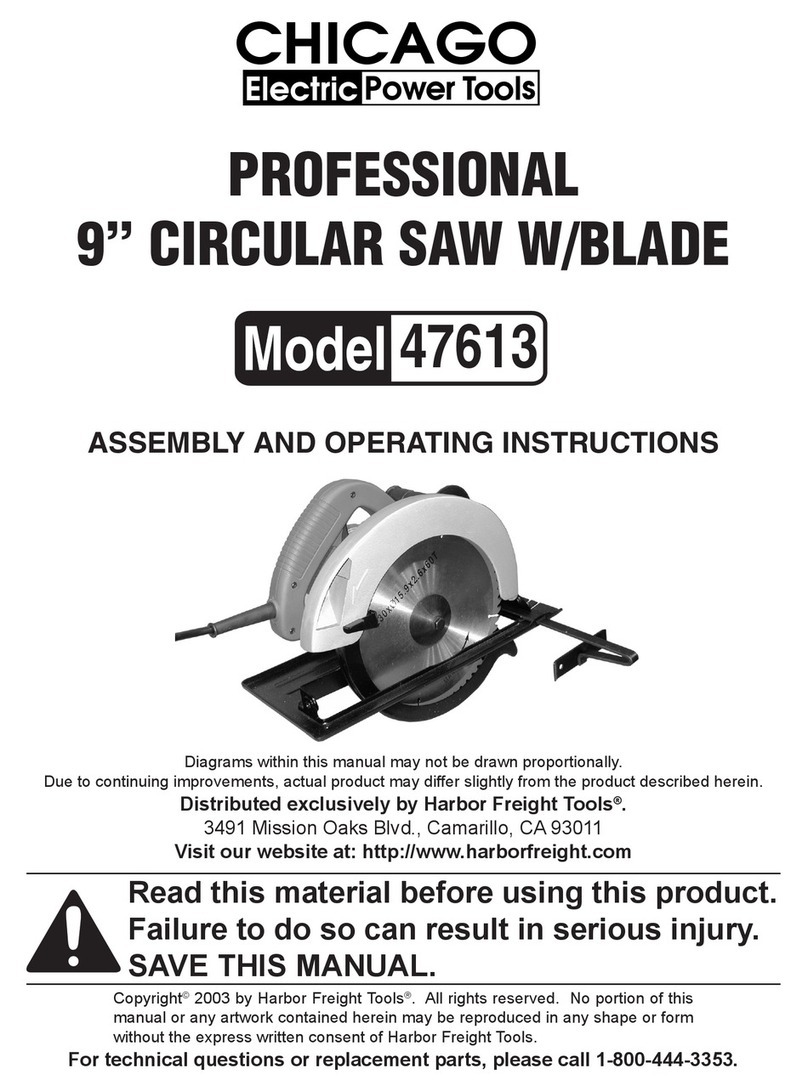
Harbor Freight Tools
Harbor Freight Tools 47613 User manual
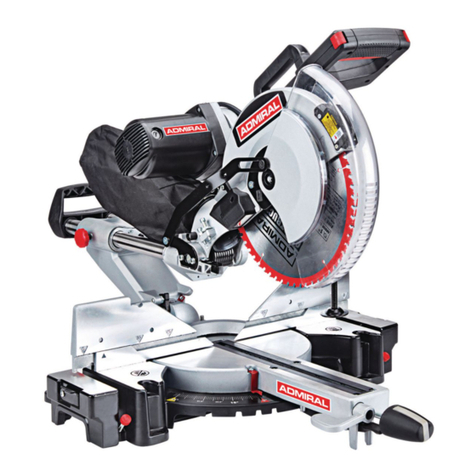
Harbor Freight Tools
Harbor Freight Tools Admiral Assembly instructions

Harbor Freight Tools
Harbor Freight Tools Central Machinery 93762 Assembly instructions
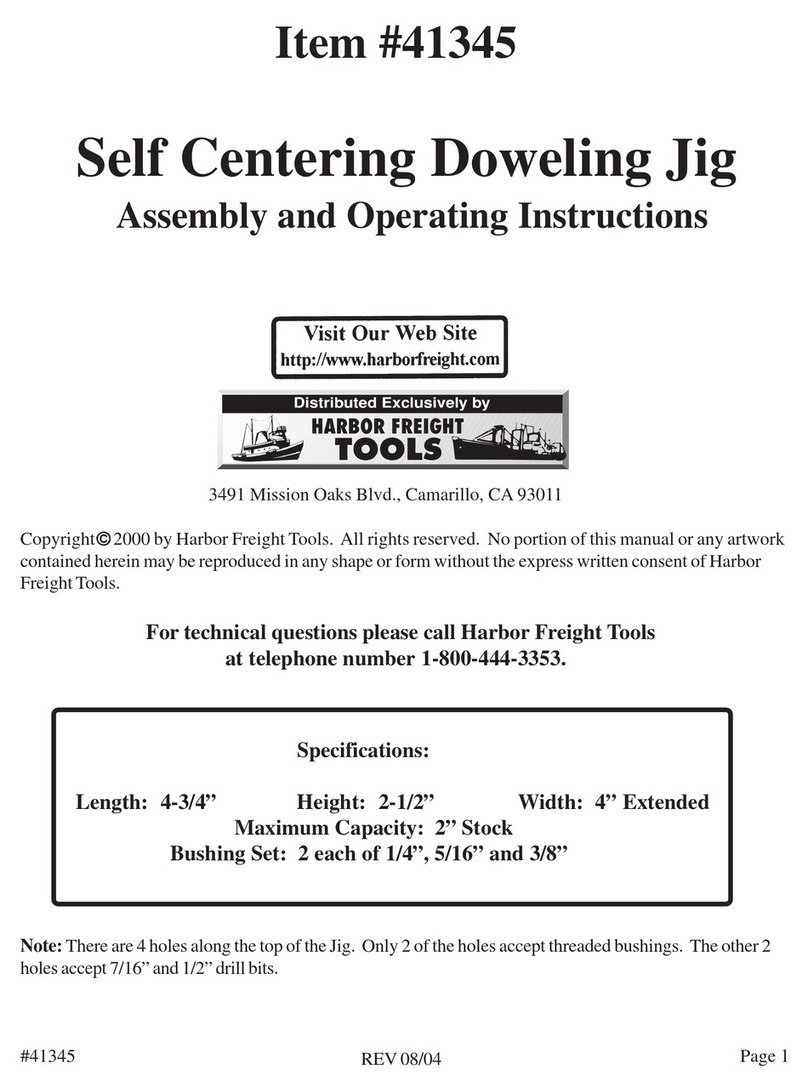
Harbor Freight Tools
Harbor Freight Tools 41345 User manual
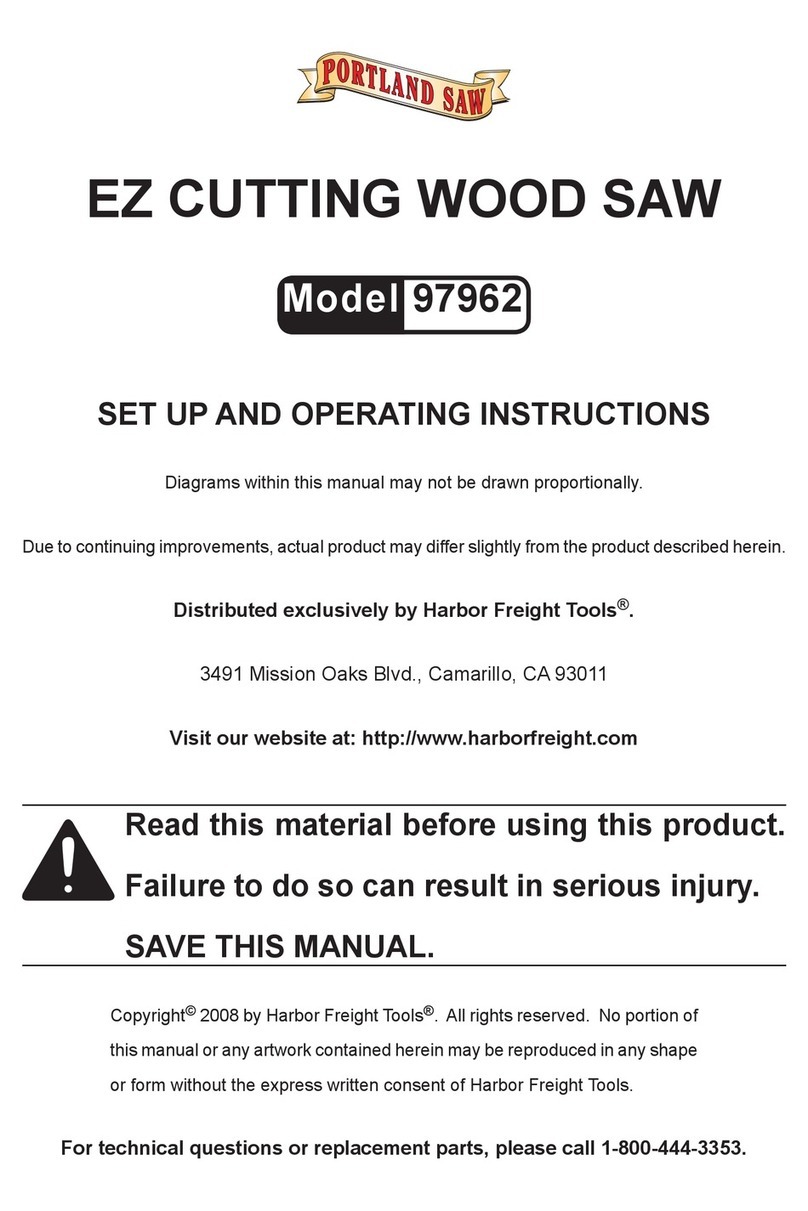
Harbor Freight Tools
Harbor Freight Tools 97962 Installation manual
